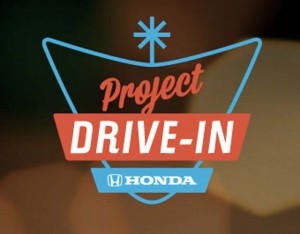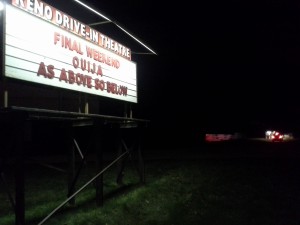Drive-Ins, and the Stubborn Usefulness of Film Nostalgia
Interstellar (2014) made its well-known debut last weekend. In Chicago, the film (yes, we can still call it that) screened in its “intended” format of 70mm at the Navy Pier IMAX. Its appearance there and at other such venues was predictably celebrated by old school cinephiles as yet another defiant declaration of celluloid’s continuing value in a culture of cinema that has increasingly done away with the old medium. Meanwhile, just across the border in the nearby state of Wisconsin, the so-called “end of film” was also marked that same weekend by a very different, less celebrated, event—the closing of the Keno Drive-In in Kenosha, Wisconsin, for the season, and most likely, permanently. In many ways, this was a more apt snapshot of film today—as well as the value in fighting for it—than Christopher Nolan’s high-profile blockbuster.
The arrival of Interstellar did little more than reiterate that celluloid’s use going forward will largely be as a high-end, niche phenomenon (confined to museums more than IMAX). And the rhetoric around film’s aesthetic superiority, frankly, obscures as many important questions in the digital age as highlights (a debate which will continue being pointless given the endlessly shifting technology). But the closing of the Keno—one of hundreds closing down in the last month or so across the United States—is more representative of the digital transition’s impact on the economics of film. Like many independent theatres, drive-ins often cannot afford the expense of converting from older 35mm projectors to digital ones (to say nothing of imminent maintenance costs)—an issue the studios and several major chains have forced by going almost exclusively to distributing movies as Digital Cinema Packages (DCPs).
 “Of the 366 Drive-in theatres left in the United States,” Variety reported in 2012, “only a handful have converted to digital projection; another 10% are expected to convert before this summer.” Last year, this led to “Project Drive-In,” a campaign funding by Honda to provide the funds necessarily for digital conversion to the rare few drive-ins that won a nationwide voting contest (a drive-in in nearby McHenry, Illinois, was one such lucky recipient).
“Of the 366 Drive-in theatres left in the United States,” Variety reported in 2012, “only a handful have converted to digital projection; another 10% are expected to convert before this summer.” Last year, this led to “Project Drive-In,” a campaign funding by Honda to provide the funds necessarily for digital conversion to the rare few drive-ins that won a nationwide voting contest (a drive-in in nearby McHenry, Illinois, was one such lucky recipient).
The Keno wasn’t nearly as fortunate—though its situation is admittedly somewhat different. While the operators of the drive-in were willing to cover costs, the shift to DCP is forcing the issue of land repurposing (including the persistent rumor of a certain “Big Box” retail mega-store). The repurposing means that The Keno is a business which risks having a projector—but no screen.
Still the value of the many closing Kenos of the world are worth exploring further—and beyond just the reassuring nostalgia offered by loving tributes such as the Going Attractions (2013) documentary. The digital conversion reveals at least one darker truth underlying the too-often-utopic rhetoric of digital cinema—innovation is not making things “easier” or “cheaper” for most people involved in the many aspects of the movie business today. Studios save considerable expenses on distribution costs, of course. Lisa Dombrowski highlighted how the “digital [conversion] will produce an 80 per cent savings on direct releasing costs [. . .] (a digital print costs between $100 and $300, while a 35mm print averages $1200 to $2000 more).”
Yet these savings have not “trickled down” to the smaller theatres dependent on 35mm—or to the audiences that pay an increasing premium on all tickets. The same can be said of independent filmmakers and others who may benefit from short-term savings in production and distribution, but will also find it increasingly difficult to get recognized or obtain a livable wage. In short, as with all market shifts in the age of late capitalism, this is simply an unsustainable long-term, financial situation.
So, it’s easy enough to look at the rampant nostalgia today surrounding the drive-in’s imminent demise—where all but a small handful will soon be Wal-Marts—and dismiss it as little more than a wistful longing for a bygone era of Americana that’s neither here nor there. Indeed, that does seem to be the city of Kenosha’s “brand,” as it were—a former auto town, with its historic Women’s Professional Baseball League-era stadium, its four museums in a twelve-block radius, its boxcar diner, its countless drive-in restaurants, or its still functioning Streetcar system. But there is also value in how the nostalgia for New Deal liberalism can be less about returning to the past, and more about using that utopic sense of history to shape something better, something more viable, still to come.



